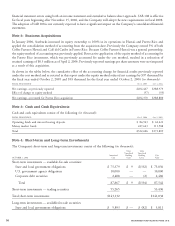Starbucks 2006 Annual Report Download - page 51
Download and view the complete annual report
Please find page 51 of the 2006 Starbucks annual report below. You can navigate through the pages in the report by either clicking on the pages listed below, or by using the keyword search tool below to find specific information within the annual report.(“APB”) Opinion No. 25, “Accounting for Stock Issued to Employees,” and related interpretations. Accordingly, because
the stock option grant price equaled the market price on the date of grant, and any purchase discounts under the
Company’s stock purchase plans were within statutory limits, no compensation expense was recognized by the Company
for stock-based compensation. As permitted by SFAS No. 123, “Accounting for Stock-Based Compensation”
(“SFAS 123”), stock-based compensation was included as a pro forma disclosure in the notes to the consolidated
financial statements.
Effective October 3, 2005, the beginning of Starbucks first fiscal quarter of 2006, the Company adopted the fair value
recognition provisions of SFAS 123R, using the modified-prospective transition method. Under this transition method,
stock-based compensation expense was recognized in the consolidated financial statements for granted, modified, or
settled stock options and for expense related to the ESPP, since the related purchase discounts exceeded the amount
allowed under SFAS 123R for non-compensatory treatment. Compensation expense recognized included the estimated
expense for stock options granted on and subsequent to October 3, 2005, based on the grant date fair value estimated in
accordance with the provisions of SFAS 123R, and the estimated expense for the portion vesting in the period for options
granted prior to, but not vested as of October 3, 2005, based on the grant date fair value estimated in accordance with the
original provisions of SFAS 123. Results for prior periods have not been restated, as provided for under the modified-
prospective method.
Total stock-based compensation expense recognized in the consolidated statement of earnings for fiscal 2006 was
$105.0 million before income taxes and consisted of stock option and ESPP expense of $94.8 million and $10.2 million,
respectively. The related total tax benefit was $36.1 million for fiscal 2006. Capitalized stock-based compensation at
October 1, 2006 was $2.1 million, and was included in “Property, plant and equipment, net” and “Inventories” on the
consolidated balance sheet.
Prior to the adoption of SFAS 123R, Starbucks presented all tax benefits resulting from the exercise of stock options as
operating cash inflows in the consolidated statements of cash flows, in accordance with the provisions of the Emerging
Issues Task Force (“EITF”) Issue No 00-15, “Classification in the Statement of Cash Flows of the Income Tax Benefit
Received by a Company upon Exercise of a Nonqualified Employee Stock Option.” SFAS 123R requires the benefits of
tax deductions in excess of the tax effect of the compensation cost recognized for those options to be classified as financing
cash inflows rather than operating cash inflows, on a prospective basis. This amount is shown as “Excess tax benefit from
exercise of stock options” on the consolidated statement of cash flows.
In November 2005, the FASB issued Staff Position No. FAS 123(R)-3, “Transition Election Related to Accounting for the
Tax Effects of Share-Based Payment Awards” (“FSP 123R-3”). The Company has elected to adopt the alternative
transition method provided in FSP 123R-3 for calculating the tax effects of stock-based compensation under SFAS 123R.
The alternative transition method includes simplified methods to establish the beginning balance of the additional
paid-in-capital pool (“APIC pool”) related to the tax effects of stock-based compensation, and for determining the
subsequent impact on the APIC pool and consolidated statements of cash flows of the tax effects of stock-based
compensation awards that are outstanding upon adoption of SFAS 123R.
For option grants made in November 2003 and thereafter, the Company may provide for immediate vesting upon
retirement for optionees who have attained at least 10 years of service and are age 55 or older. Prior to adoption of
SFAS 123R, the Company amortized the expense over the related vesting period with acceleration of expense upon
retirement. With the adoption of SFAS 123R, the accounting treatment for retirement features changed. Expense for
awards made prior to adoption of SFAS 123R is still amortized over the vesting period until retirement, at which point
any remaining unrecognized expense is immediately recognized. For awards made on or after October 3, 2005, the related
expense is recognized either from grant date through the date the employee reaches the years of service and age
requirements, or from grant date through the stated vesting period, whichever is shorter.
STARBUCKS CORPORATION, FORM 10-K 47
























